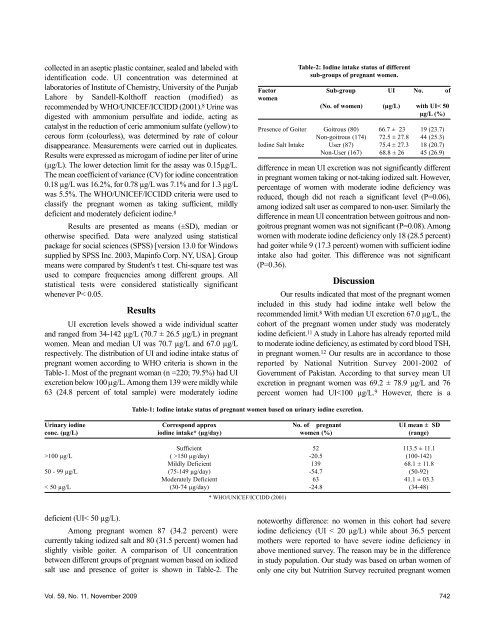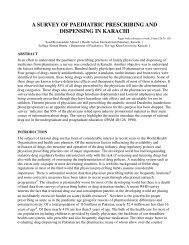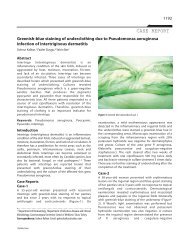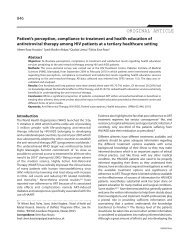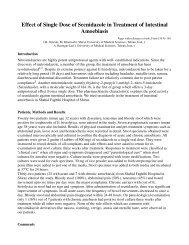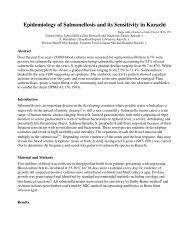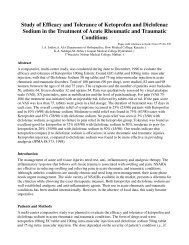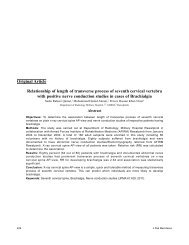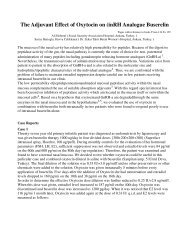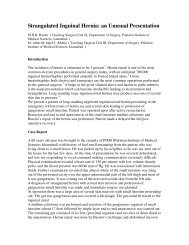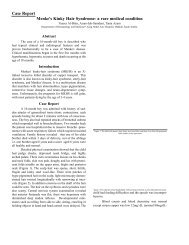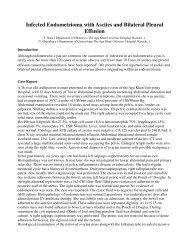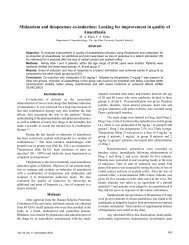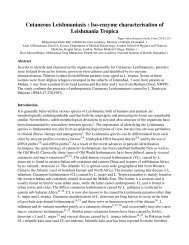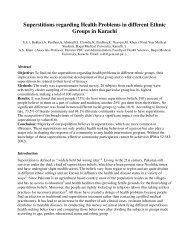Pages - Nov-09--1:Pages - Nov-09--1.qxd.qxd - Journal of Pakistan ...
Pages - Nov-09--1:Pages - Nov-09--1.qxd.qxd - Journal of Pakistan ...
Pages - Nov-09--1:Pages - Nov-09--1.qxd.qxd - Journal of Pakistan ...
You also want an ePaper? Increase the reach of your titles
YUMPU automatically turns print PDFs into web optimized ePapers that Google loves.
collected in an aseptic plastic container, sealed and labeled with<br />
identification code. UI concentration was determined at<br />
laboratories <strong>of</strong> Institute <strong>of</strong> Chemistry, University <strong>of</strong> the Punjab<br />
Lahore by Sandell-Kolth<strong>of</strong>f reaction (modified) as<br />
recommended by WHO/UNICEF/ICCIDD (2001). 8 Urine was<br />
digested with ammonium persulfate and iodide, acting as<br />
catalyst in the reduction <strong>of</strong> ceric ammonium sulfate (yellow) to<br />
cerous form (colourless), was determined by rate <strong>of</strong> colour<br />
disappearance. Measurements were carried out in duplicates.<br />
Results were expressed as microgam <strong>of</strong> iodine per liter <strong>of</strong> urine<br />
(µg/L). The lower detection limit for the assay was 0.15µg/L.<br />
The mean coefficient <strong>of</strong> variance (CV) for iodine concentration<br />
0.18 µg/L was 16.2%, for 0.78 µg/L was 7.1% and for 1.3 µg/L<br />
was 5.5%. The WHO/UNICEF/ICCIDD criteria were used to<br />
classify the pregnant women as taking sufficient, mildly<br />
deficient and moderately deficient iodine. 8<br />
Results are presented as means (±SD), median or<br />
otherwise specified. Data were analyzed using statistical<br />
package for social sciences (SPSS) [version 13.0 for Windows<br />
supplied by SPSS Inc. 2003, Mapinfo Corp. NY, USA]. Group<br />
means were compared by Student's t test. Chi-square test was<br />
used to compare frequencies among different groups. All<br />
statistical tests were considered statistically significant<br />
whenever P< 0.05.<br />
Results<br />
UI excretion levels showed a wide individual scatter<br />
and ranged from 34-142 µg/L (70.7 ± 26.5 µg/L) in pregnant<br />
women. Mean and median UI was 70.7 µg/L and 67.0 µg/L<br />
respectively. The distribution <strong>of</strong> UI and iodine intake status <strong>of</strong><br />
pregnant women according to WHO criteria is shown in the<br />
Table-1. Most <strong>of</strong> the pregnant woman (n =220; 79.5%) had UI<br />
excretion below 100 µg/L. Among them 139 were mildly while<br />
63 (24.8 percent <strong>of</strong> total sample) were moderately iodine<br />
deficient (UI< 50 µg/L).<br />
Among pregnant women 87 (34.2 percent) were<br />
currently taking iodized salt and 80 (31.5 percent) women had<br />
slightly visible goiter. A comparison <strong>of</strong> UI concentration<br />
between different groups <strong>of</strong> pregnant women based on iodized<br />
salt use and presence <strong>of</strong> goiter is shown in Table-2. The<br />
difference in mean UI excretion was not significantly different<br />
in pregnant women taking or not-taking iodized salt. However,<br />
percentage <strong>of</strong> women with moderate iodine deficiency was<br />
reduced, though did not reach a significant level (P=0.06),<br />
among iodized salt user as compared to non-user. Similarly the<br />
difference in mean UI concentration between goitrous and nongoitrous<br />
pregnant women was not significant (P=0.08). Among<br />
women with moderate iodine deficiency only 18 (28.5 percent)<br />
had goiter while 9 (17.3 percent) women with sufficient iodine<br />
intake also had goiter. This difference was not significant<br />
(P=0.36).<br />
Discussion<br />
Our results indicated that most <strong>of</strong> the pregnant women<br />
included in this study had iodine intake well below the<br />
recommended limit. 8 With median UI excretion 67.0 µg/L, the<br />
cohort <strong>of</strong> the pregnant women under study was moderately<br />
iodine deficient. 11 A study in Lahore has already reported mild<br />
to moderate iodine deficiency, as estimated by cord blood TSH,<br />
in pregnant women. 12 Our results are in accordance to those<br />
reported by National Nutrition Survey 2001-2002 <strong>of</strong><br />
Government <strong>of</strong> <strong>Pakistan</strong>. According to that survey mean UI<br />
excretion in pregnant women was 69.2 ± 78.9 µg/L and 76<br />
percent women had UI100 µg/L ( >150 µg/day) -20.5 (100-142)<br />
Mildly Deficient 139 68.1 ± 11.8<br />
50 - 99 µg/L (75-149 µg/day) -54.7 (50-92)<br />
Moderately Deficient 63 41.1 ± 03.3<br />
< 50 µg/L (30-74 µg/day) -24.8 (34-48)<br />
* WHO/UNICEF/ICCIDD (2001)<br />
Table-2: Iodine intake status <strong>of</strong> different<br />
sub-groups <strong>of</strong> pregnant women.<br />
Factor Sub-group UI No. <strong>of</strong><br />
women<br />
(No. <strong>of</strong> women) (µg/L) with UI< 50<br />
µg/L (%)<br />
Presence <strong>of</strong> Goiter Goitrous (80) 66.7 ± 23 19 (23.7)<br />
Non-goitrous (174) 72.5 ± 27.8 44 (25.3)<br />
Iodine Salt Intake User (87) 75.4 ± 27.3 18 (20.7)<br />
Non-User (167) 68.8 ± 26 45 (26.9)<br />
noteworthy difference: no women in this cohort had severe<br />
iodine deficiency (UI < 20 µg/L) while about 36.5 percent<br />
mothers were reported to have severe iodine deficiency in<br />
above mentioned survey. The reason may be in the difference<br />
in study population. Our study was based on urban women <strong>of</strong><br />
only one city but Nutrition Survey recruited pregnant women<br />
Vol. 59, No. 11, <strong>Nov</strong>ember 20<strong>09</strong> 742


